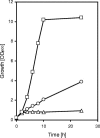Pyruvate:quinone oxidoreductase in Corynebacterium glutamicum: molecular analysis of the pqo gene, significance of the enzyme, and phylogenetic aspects
- PMID: 16452416
- PMCID: PMC1367228
- DOI: 10.1128/JB.188.4.1341-1350.2006
Pyruvate:quinone oxidoreductase in Corynebacterium glutamicum: molecular analysis of the pqo gene, significance of the enzyme, and phylogenetic aspects
Abstract
Corynebacterium glutamicum recently has been shown to possess pyruvate:quinone oxidoreductase (PQO), catalyzing the oxidative decarboxylation of pyruvate to acetate and CO2 with a quinone as the electron acceptor. Here, we analyze the expression of the C. glutamicum pqo gene, investigate the relevance of the PQO enzyme for growth and amino acid production, and perform phylogenetic studies. Expression analyses revealed that transcription of pqo is initiated 45 bp upstream of the translational start site and that it is organized in an operon together with genes encoding a putative metal-activated pyridoxal enzyme and a putative activator protein. Inactivation of the chromosomal pqo gene led to the absence of PQO activity; however, growth and amino acid production were not affected under either condition tested. Introduction of plasmid-bound pqo into a pyruvate dehydrogenase complex-negative C. glutamicum strain partially relieved the growth phenotype of this mutant, indicating that high PQO activity can compensate for the function of the pyruvate dehydrogenase complex. To investigate the distribution of PQO enzymes in prokaryotes and to clarify the relationship between PQO, pyruvate oxidase (POX), and acetohydroxy acid synthase enzymes, we compiled and analyzed the phylogeny of respective proteins deposited in public databases. The analyses revealed a wide distribution of PQOs among prokaryotes, corroborated the hypothesis of a common ancestry of the three enzymes, and led us to propose that the POX enzymes of Lactobacillales were derived from a PQO.
Figures




Similar articles
-
Corynebacterium glutamicum pyruvate:quinone oxidoreductase: an enigmatic metabolic enzyme with unusual structural features.FEBS J. 2024 Oct;291(20):4501-4521. doi: 10.1111/febs.17232. Epub 2024 Jul 30. FEBS J. 2024. PMID: 39080980
-
E1 enzyme of the pyruvate dehydrogenase complex in Corynebacterium glutamicum: molecular analysis of the gene and phylogenetic aspects.J Bacteriol. 2005 Sep;187(17):6005-18. doi: 10.1128/JB.187.17.6005-6018.2005. J Bacteriol. 2005. PMID: 16109942 Free PMC article.
-
Pyruvate:quinone oxidoreductase from Corynebacterium glutamicum: purification and biochemical characterization.J Bacteriol. 2005 Feb;187(3):862-71. doi: 10.1128/JB.187.3.862-871.2005. J Bacteriol. 2005. PMID: 15659664 Free PMC article.
-
The pyruvate dehydrogenase complex of Corynebacterium glutamicum: an attractive target for metabolic engineering.J Biotechnol. 2014 Dec 20;192 Pt B:339-45. doi: 10.1016/j.jbiotec.2013.12.019. Epub 2014 Jan 29. J Biotechnol. 2014. PMID: 24486441 Review.
-
The respiratory chain of Corynebacterium glutamicum.J Biotechnol. 2003 Sep 4;104(1-3):129-53. doi: 10.1016/s0168-1656(03)00144-5. J Biotechnol. 2003. PMID: 12948635 Review.
Cited by
-
Metabolic engineering of Corynebacterium glutamicum for 2-ketoisovalerate production.Appl Environ Microbiol. 2010 Dec;76(24):8053-61. doi: 10.1128/AEM.01710-10. Epub 2010 Oct 8. Appl Environ Microbiol. 2010. PMID: 20935122 Free PMC article.
-
Alternative acetate production pathways in Chlamydomonas reinhardtii during dark anoxia and the dominant role of chloroplasts in fermentative acetate production.Plant Cell. 2014 Nov;26(11):4499-518. doi: 10.1105/tpc.114.129965. Epub 2014 Nov 7. Plant Cell. 2014. PMID: 25381350 Free PMC article.
-
Bio-based production of organic acids with Corynebacterium glutamicum.Microb Biotechnol. 2013 Mar;6(2):87-102. doi: 10.1111/1751-7915.12013. Epub 2012 Dec 2. Microb Biotechnol. 2013. PMID: 23199277 Free PMC article. Review.
-
Platform engineering of Corynebacterium glutamicum with reduced pyruvate dehydrogenase complex activity for improved production of L-lysine, L-valine, and 2-ketoisovalerate.Appl Environ Microbiol. 2013 Sep;79(18):5566-75. doi: 10.1128/AEM.01741-13. Epub 2013 Jul 8. Appl Environ Microbiol. 2013. PMID: 23835179 Free PMC article.
-
Application of a genetically encoded biosensor for live cell imaging of L-valine production in pyruvate dehydrogenase complex-deficient Corynebacterium glutamicum strains.PLoS One. 2014 Jan 17;9(1):e85731. doi: 10.1371/journal.pone.0085731. eCollection 2014. PLoS One. 2014. PMID: 24465669 Free PMC article.
References
-
- Abdel-Hamid, A. M., M. M. Attwood, and J. R. Guest. 2001. Pyruvate oxidase contributes to the aerobic growth efficiency of Escherichia coli. Microbiology 147:1483-1498. - PubMed
-
- Altschul, S. F., W. Gish, W. Miller, E. W. Myers, and D. J. Lipman. 1990. Basic local alignment search tool. J. Mol. Biol. 215:403-410. - PubMed
-
- Birnboim, H. C. 1983. A rapid alkaline extraction method for the isolation of plasmid DNA. Methods Enzymol. 100:243-255. - PubMed
-
- Blake, R. I. I., T. A. O'Brien, R. B. Gennis, and L. P. Hager. 1982. Role of the divalent metal cation in the pyruvate oxidase reaction. J. Biol. Chem. 257:9605-9611. - PubMed
-
- Blake, R., and L. P. Hager. 1978. Activation of pyruvate oxidase by monomeric and micellar amphiphiles. J. Biol. Chem. 253:1963-1971. - PubMed
Publication types
MeSH terms
Substances
LinkOut - more resources
Full Text Sources
Other Literature Sources
Molecular Biology Databases

